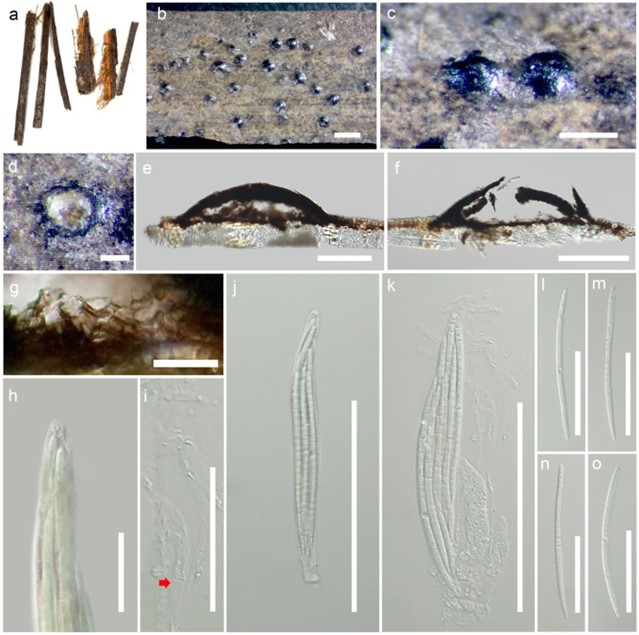Linocarpon calami Konta, in Hyde et al., Mycosphere 11(1): 686 (2020)
Index Fungorum number: IF 556362; MycoBank number: MB 556362; Facesoffungi number: FoF 06024;
Etymology – Named after the host genus, Calamus.
Holotype – MFLU 15-0277.
Saprobic on petioles of Calamus. Sexual morph: Ascomata 147–187 μm high × 565–732 μm diameter (x̅ = 165 × 637 μm, n = 10), solitary or aggregated, superficial, comprising black, dome-shaped, raised, blister-like areas, subglobose in section, flattened at the base, with a central ostiole. Peridium 33–70 μm diameter ( x̅ = 47 μm, n = 10), outer cells merging with the host epidermal cells, composed of dark brown to black cells of textura angularis. Paraphyses 3–6 µm diameter (x̅ = 4 μm, n = 10), numerous, septate, longer than asci. Asci 120–160 × 13–21 μm (x̅ = 140 × 16 μm, n = 20), 8–spored, unitunicate, cylindrical, long–pedicellate, with a J–, wedge–shaped, subapical ring. Ascospores 78–95 × 2–4 μm ( x̅ = 91 × 5 μm, n = 20), parallel when immature, becoming spiral when mature, hyaline, filiform, straight or curved, aseptate, containing numerous refringent septum–like bands, ends rounded, without polar mucilaginous appendage at the apex, smooth-walled. Asexual morph: Undetermined.
Material examined – THAILAND, Phang–Nga Province, on dead petioles of Calamus (Arecaceae), 6 December 2014, Sirinapa Konta DNH02a, MFLU 15–0277, holotype.
Notes – A new species is introduced based on morphology and comparison with known Linocarpon species as well as species reported in Thailand. Linocarpon calami fits with the generic concept of Linocarpon in having superficial, dome-shaped, cylindrical asci, with J-, apical ring and filiform ascospores with refringent bands. Comparisons of Linocarpon species known in Thailand show that L. calami differs from L. arengae in having smaller ascomata, asci and ascospores, and ascospores without polar mucilaginous appendage, while Linocarpon calami differs from L. cocois in having larger ascospores containing numerous refringent septum-like bands. Therefore, Linocarpon calami is introduced as a new species and the first geological record from the host genus Calanus (Arecaceae) in Thailand.

Figure 149 – Linocarpon calami (MFLU 15–0277, holotype). a, b Appearance of ascomata on host substrate. c Close up of ascoma. d Off white to yellowish ascospores mass. e, f Section of ascoma. g Peridium. h J-, reaction of apical ring. i Paraphyses (septate at the red arrow). j, k Asci (k mature asci with immature asci and paraphyses). l-o Ascospores. Scale bars: b = 1000 μm, c = 500 μm, d-f = 200 μm, g-h = 20 μm, i-o = 50 μm.
